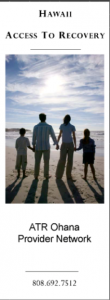ATR Ohana Program Overview
| Grant Summary | Grant Overview Presentation |
Hawaii ATR Vision Statement
The Vision of the Hawaii Access To Recovery (ATR Ohana) Project is to strengthen and heal shattered lives and families. The ATR Ohana envisions a system where individuals with substance use disorders are treated with dignity and respect, and that choice among treatment and recovery support service providers is maximized and expedited wherever possible.
Hawaii ATR Goal Statement
The Goals of the ATR Ohana Project are to 1) support client choice; (2) expand access to a wide range of treatment and recovery support services, including faith- and culturally-based providers; and 3) to increase capacity of the treatment and recovery support services in Hawaii’s recovery-oriented system of care.
Substance Abuse and Mental Health Services Administration (SAMHSA) Vision and Mission
“To build resilience and facilitate recovery“ offering “a life in the community for everyone.“
Proposed Approach
The ATR Ohana will emphasize and facilitate client choice among substance use disorder treatment and recovery support service providers through electronic voucher payment system where the funding follows the client to their choice of service and agency from the ATR Ohana network of approved providers.
The ATR Ohana promotes self-care at the most fundamental levels, including empowering clients to select their service providers and to be actively involved in decisions affecting their life, care, and treatment.
The ATR Ohana will expand access to services for individuals with substance use disorders age 12 and older, previously incarcerated individuals re-entering community settings, drug court clients, Hawaiian Natives and Asian Pacific Island populations, Deployed Veterans, Military, National Guard, Reserves, and their families, and to those experiencing health disparity such as dental disease related to use of methamphetamines and HIV/AIDS patients.
The ATR Ohana will partner with Hawaii’s recovery-oriented systems of care, including community-based, faith-based, culture-based, and secular providers to maximize local access to ATR Ohana clients for services in categories relevant to their individual recovery needs.
The ATR Ohana funds are considered a “payer of last resort” and all other funding options must be exhausted before ATR Ohana funds will be paid to treatment and recovery support service providers.
Target Area
The ATR Ohana Project will provide services on Oahu and will expand to at least one neighbor island during the first year of the grant.
Target Populations
The ATR Ohana Project will serve individuals age 12 and older with substance use disorders. The ATR Ohana will emphasize the need to reach and serve a number of special populations in Hawaii including, youth ages 12 through 17, Native Hawaiians, Pacific Islanders, drug court clients, previously incarcerated individuals re-entering the community, Deployed Veterans, Military, National Guard, Reserves and their families, and individuals experiencing health disparity, including those with methamphetamine related dental disease and those with HIV/AIDS.
Alcohol and Drug Abuse Division
601 Kamokila Blvd. Room 360
Kapolei, Hawai’i, 96707
(808) 692-7506
